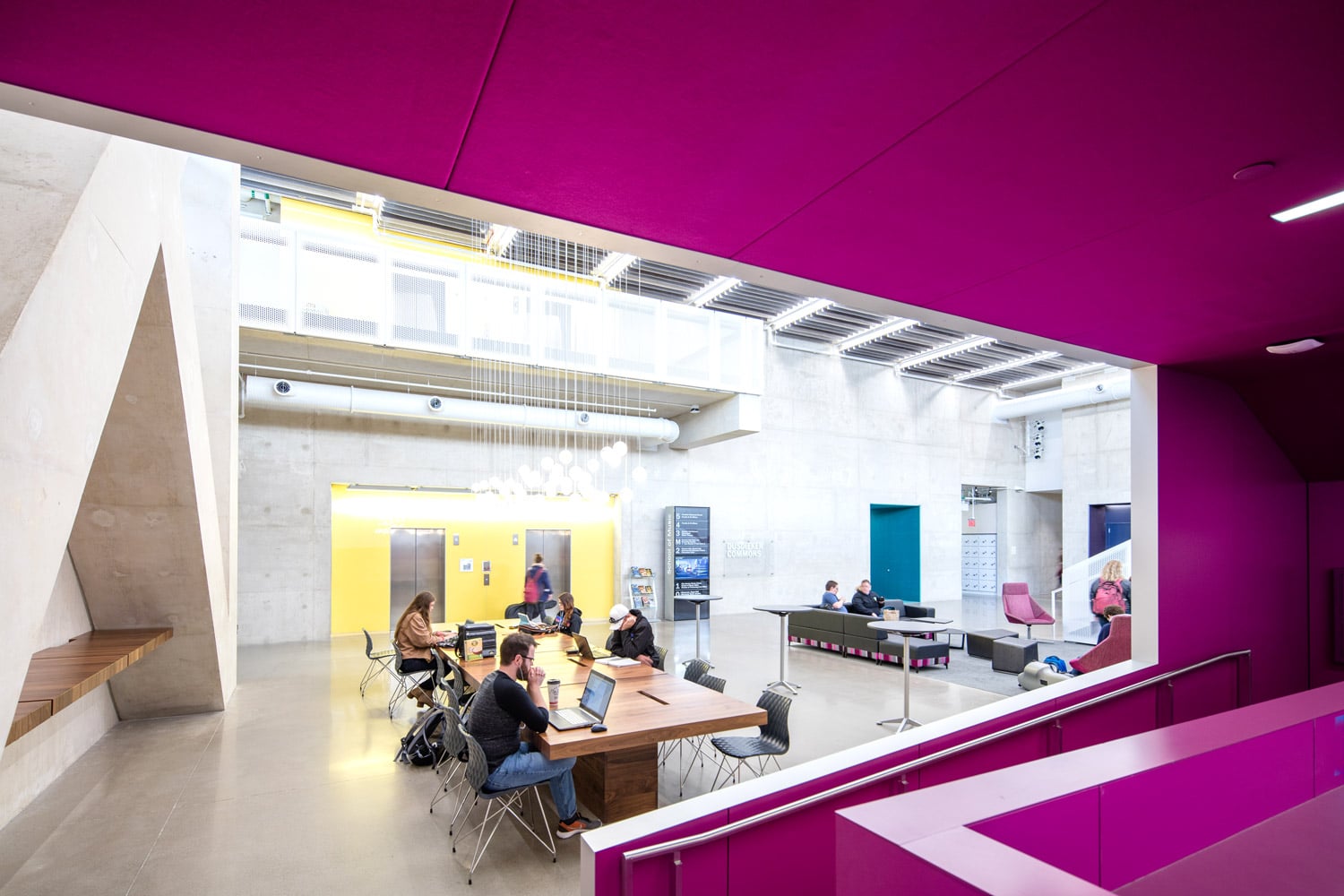
The architects behind the Voxman Music Building at the University of Iowa used digital information technology to optimize acoustics and design. [Photo: Courtesy of Adam Hunter/LMN Architects]
Here’s exactly how data collection and automated building functions are boosting the intelligence of the built environment.
Around three million people move to cities each week, according to UN-Habitat, and it’s estimated that, by 2050, nearly two-thirds of the world’s population will live in cities. In order to keep up with rapid growth and efficiently handle added infrastructure burdens, cities may need to get smarter.
The term “smart city” was coined at the end of the 20th century and, although it has been used to describe everything from already advanced Shanghai to Jetsons-like cities in the sky, it essentially refers to a metro that utilizes data collection and information technology to optimize how it uses energy. Not surprisingly, smart buildings—with their own, more localized embrace of automated energy control—play a major function in smart cities. If buildings are made smarter, cities can inevitably follow close behind. So what exactly makes a smart building smart?
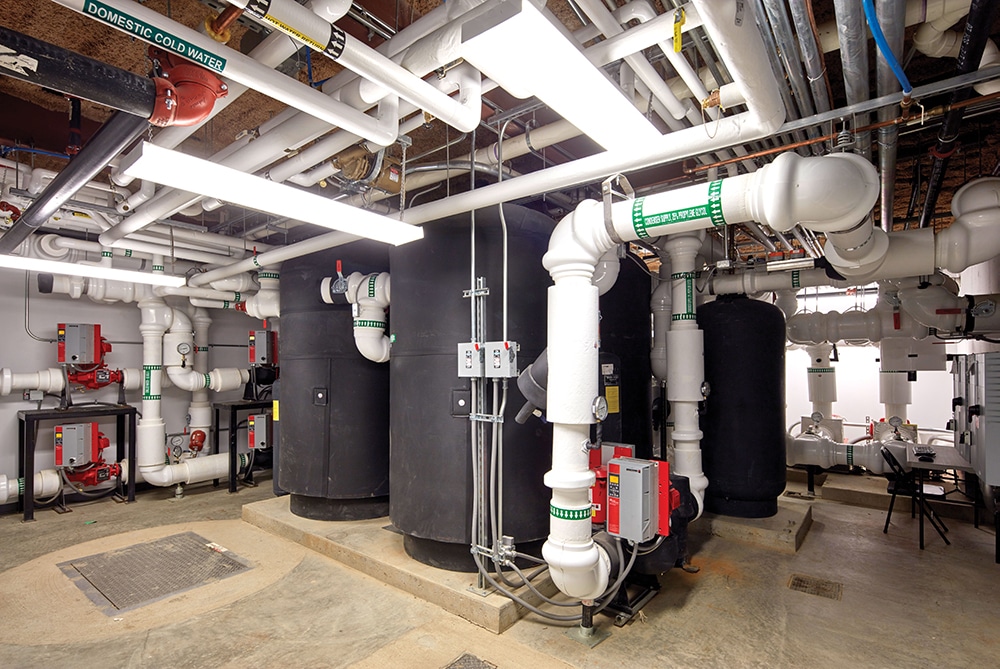
Messana Radiant Cooling Ray Magic system uses radiant gypsum panels to cool and heat rooms. [Photo: Courtesy of Messana]
Smart HVAC Tracks and Fixes Heating and Cooling Problems in Real Time
One of smart buildings’ biggest selling points are their HVAC systems, which are often powered by the Internet of Things (IoT), the web-based connection of embedded tech inside systems that collects and transmits data.
In order to maintain building temperatures, smart HVAC systems monitor the temperatures outside and inside the building to provide optimal comfort. Smart thermostats can adjust a room’s temperature based on your pre-programmed preferences and maintain it throughout the day. Additionally, zoning systems can offer total control over heating and air conditioning throughout a building by dividing it into zones that can be set to different temperatures.
Smart HVAC systems also monitor energy consumption and how well heating, ventilation, and air conditioning units are performing throughout a site. The system can detect and correct the problems throughout the building as soon as they occur and record data along the way for building owners’ future use. They also can limit energy consumption in parts of the building that are used less than other areas.
These systems’ use of monitoring and correcting helps to reduce overall energy usage within the buildings in which they’re installed, helping the environment tremendously. Forty percent of global energy comes from buildings. By monitoring the amount of energy smart buildings are using, building owners can make cuts and decrease their overall energy output.
On a citywide scale, this type of technology can be groundbreaking. Because they’re online, smart HVAC systems across a city can be connected by the IoT, creating a large city grid that would help to reduce energy citywide and significantly increase overall efficiency.
The smart grid concept is already being tested around the globe. In Helsinki’s Smart Kalasatama district, every building is connected to a smart grid. Residents can check whether their lights and electrical appliances are on using a remote control system when they’re not home. Similarly, the system allows for real-time observation of water and electricity so residents know how much or little of these resources they use day-to-day.

Smart-lighting pioneers Crestron are among the world’s most successful smart-building technology developers, employing more than 2,500 employees worldwide. [Photo: Courtesy of Crestron]
Smart Lighting Automatically Dims or Brightens Based on Available External Light
Another way smart buildings help save energy is with smart lighting. Regular light bulbs are swapped for smart, LED light bulbs and connected to a single hub that controls the entire lighting system within the building. From there, users can monitor energy usage and dim or brighten based on external light. Lights can also turn off when rooms are unoccupied. Some smart bulbs can even change colors.
Lighting accounts for 19% of U.S. energy production. Using smart lighting technology can help to reduce that number.
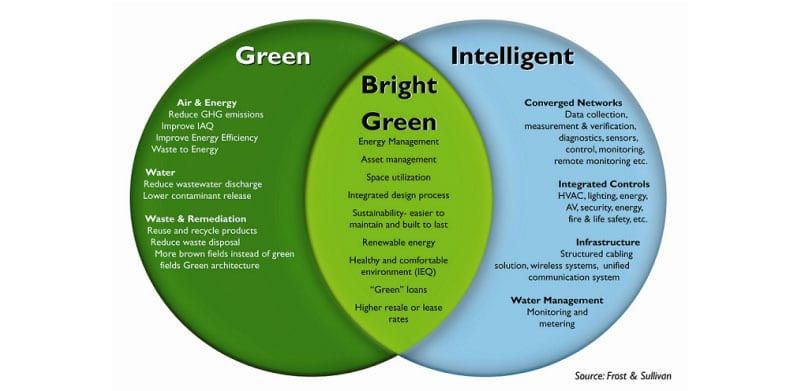
[Diagram: Courtesy of Continental Automated Buildings Association]
A Smart Building That’s Also Green is a “Bright Green” Building
Despite their many eco-friendly features, “smart buildings” do not automatically equate to “green buildings.” Smart buildings generally focus in on energy efficiency and air quality when it comes to sustainable features. Green buildings generally take it a few steps further when it comes to long-term environmental fixes.
When a smart building is also green it’s often called something else—a “bright green” building. Bright green buildings combine concepts from the two types of buildings, such as energy management, space utilization, and “green” loans, among others. However, there are lots of features that green and intelligent buildings do not share.
Green buildings generally focus on three overarching categories: air and energy, water, and waste and remediation. These categories include initiatives that aim to reduce greenhouse gas emissions, turn waste to energy, and reuse/recycle products. Smart buildings, on the other hand, focus primarily on these four categories: converged networks, integrated controls, infrastructure, and water management. Those categories can include initiatives that focus on data collection, structured cabling solutions, and a unified communication system.
So while there is some overlap between the two, particularly in terms of an energy-efficiency focus, “green” and “smart” shouldn’t necessarily be considered synonymous.
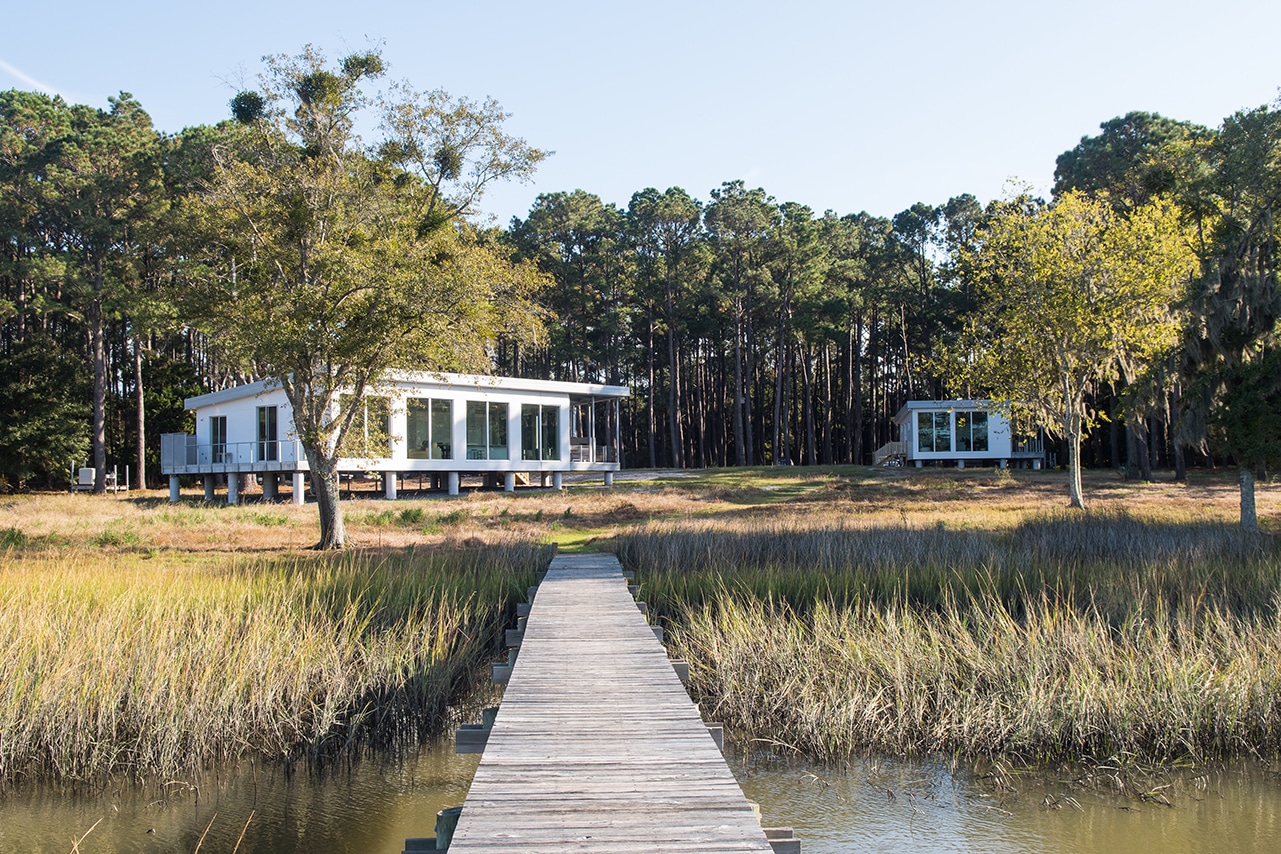
Prefabricated steel buildings go up quicker than if you were to use traditional building materials. [Photo: Courtesy of EcoSteel]
Newer Smart Buildings Tend to Use Durable, Sustainable Materials
Green or not, smart buildings are certainly sustainable by nature. The energy-saving software implemented in these buildings is meant to reduce each structure’s carbon footprint, and they have widely succeeded. Commercial, residential, and industrial buildings account for 33% of carbon dioxide equivalent (CO2e) emissions, and smart building technology could save between 8% and 15% annually per building after installment, according to a Jones Lang LaSalle report.
Newer smart buildings also often use long-lasting materials to build sustainable structures. EcoSteel, a California-based company that focuses on steel building systems, aims to do just that. Their durable steel structures can withstand natural disasters ranging from fires to severe storms that would likely cause wood-built homes to warp or decompose. Another material that will make buildings last is the newly invented smart concrete. Though not yet on the market, smart concrete is packed with pods filled with dormant bacteria spores and calcium lactate. If the concrete cracks and water seeps in, these pods will be activated, creating limestone and filling in the cracks.
These concepts combined give smart buildings an advantage in surviving threats to buildings, from climate change to the natural passing of time. Preparing cities to combat and overcome climate change will be a great challenge, but one that is inevitable.
The Cost of Smartening a Building is Worth it in the Long Run
Given the various technologies smart buildings tout, one word may come to mind when thinking about investing in a smart building: cost. But going smart is not as expensive as one might think.
To turn a not-so-smart building smart, building management systems (BMS) are generally implemented; they are largely thought of as the backbone of smart buildings. Using a BMS to make an old building smarter costs $250,000 per 100,000 square feet on average, making it widely unattainable for many. But the IoT is revolutionizing that.
IoT offers networks that use minimal power and affordable sensors. IoT-based technology can decrease smart building costs to prices as low as $5,000 to $50,000, according to buildings.com.
In addition to the decreasing cost of smart software itself, the eco-friendly smart lighting and energy-monitoring technologies these buildings provide help owners and renters save, too. The energy cuts these technologies provide lead to big financial cuts on utilities: Offices will commonly see up to 18% savings, retail and hospitals will see 14%, and hotels will see 8%.
For managers and investors in real estate, smart buildings can boost investment values. By enhancing a building’s performance with smart technology, building owners can ensure their property will increase significantly in value.
Intelligent buildings can add as much as 11.8% in lease value and can generate sale values up to 5% to 35% higher, according to the European Commission. No matter the building’s purpose—retail, residential, office, or other—smart technology is guaranteed to benefit its occupants. The added desirability in turn results in lower vacancy rates.
While making an entire city smart all at once would certainly rack up a price tag, changing the infrastructure one building at a time is not as prohibitive an investment. Plus, the savings over the long-run are significant.
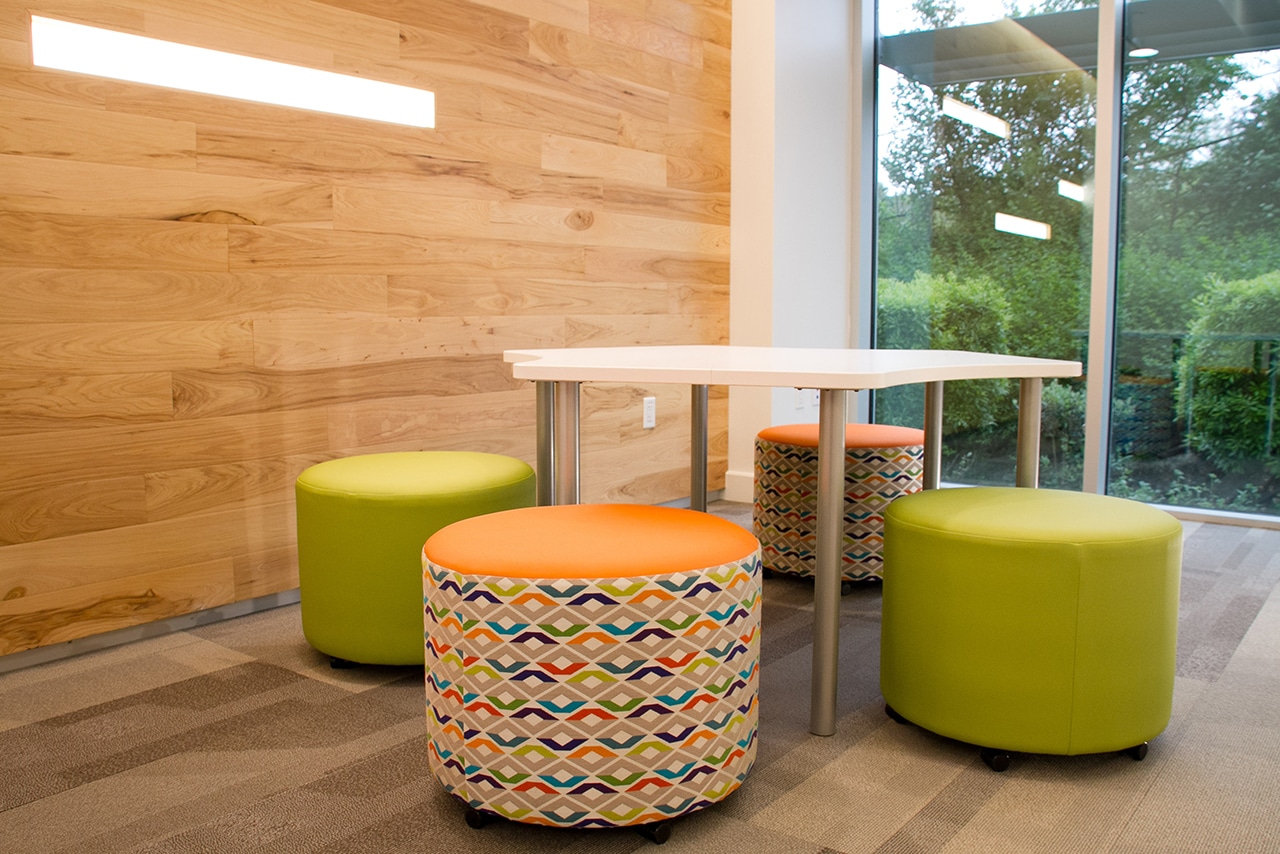
[Photo: Courtesy of National Business Furniture]
Some Smart Buildings Boast Health Boons for Occupants
Sustainability and savings aside, smart buildings aim to benefit the people that occupy them.
Indoor air quality (IAQ) is among the many challenges normal buildings often face. It is generally two to five times worse than outdoor air quality and can lead to decreased productivity, focus, and long- and short-term illness. But intelligent building technologies like smart HVAC systems can monitor IAQ and filter out unwanted elements.
The technology is able to detect overused and under-cleaned areas within the building. Recognizing dirty space early allows facility managers to disperse staff to cleaner areas or repair problem spots before they become bigger issues.
Smart building technology can also help to keep external danger out. Security cameras are a given in these smarter-than-most structures of course, but many buildings also have lockdown systems in place in case of imminent threat.
In addition to safety, smart buildings can also prioritize comfort. Smart HVAC systems already monitor energy distribution throughout smart buildings, but future software could take that to the next level, providing people with comfort before they even think to ask for it. A team of researchers at University of Southern California’s School of Architecture has begun researching biosensor technology, which will allow buildings to assess physiological signals such as heart rate and skin temperature to maintain ultimate coziness.
In America, 80% of Americans feel stressed at work, according to the American Institute of Stress. These types of smart technologies implemented in a city setting could help to significantly lower that number, keeping American workers healthier mentally and physically.
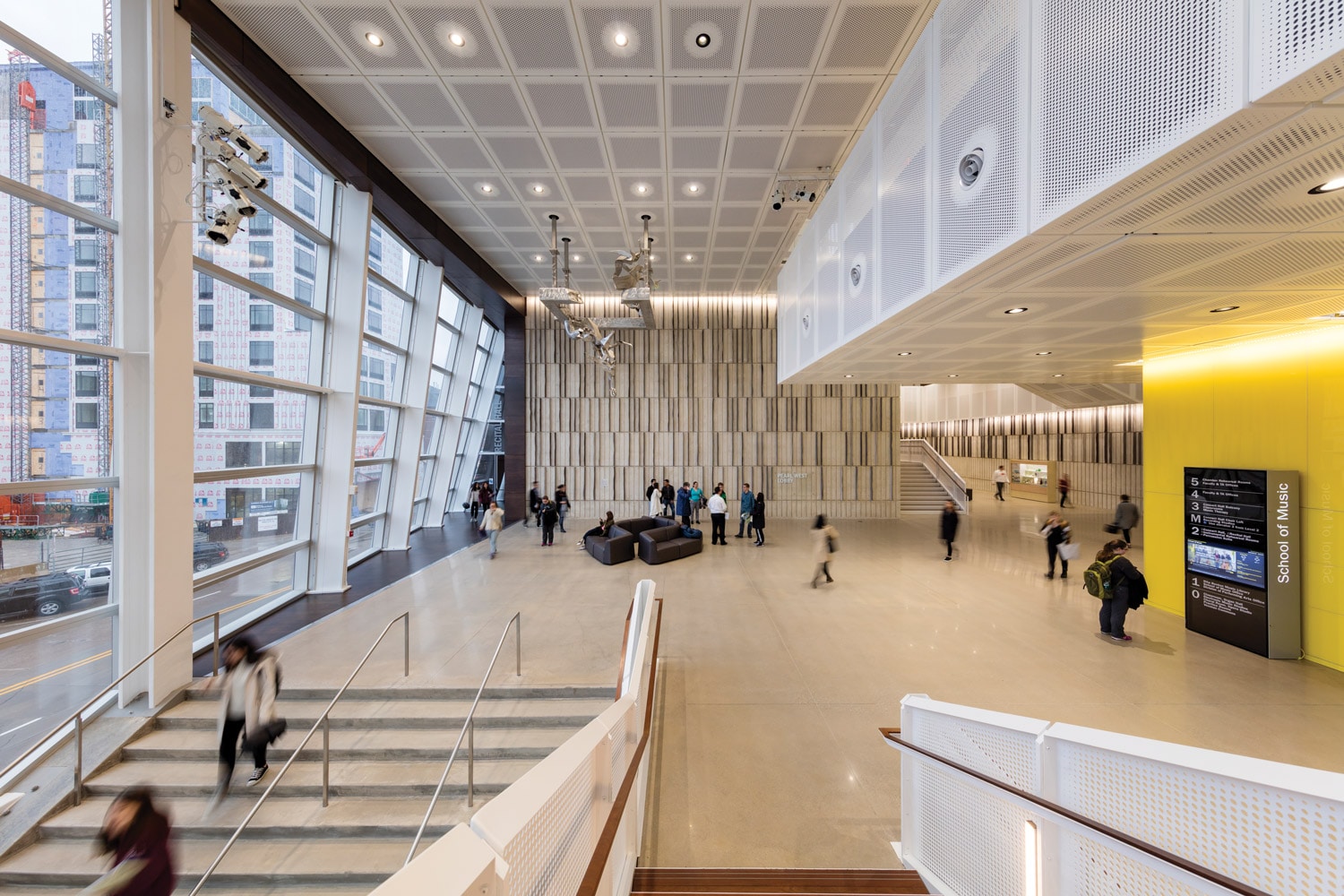
The concert hall at the Voxman Music Building, at the University of Iowa, is made up of nearly a thousand folded-aluminum composite modules, all digitally designed and produced. [Photo: Tim Griffith]
Digital Design Systems Help Streamline How Buildings Run
Across the globe, smart buildings are proving to be an attractive option—and sometimes on grand scales. Amsterdam’s The Edge, dubbed “The Smartest Building in the World” by Bloomberg, is one example that’s changing what modern work life looks like. The building boasts technology that fine-tunes the building’s microclimate based on how employees move around it. It also connects employees’ digital profiles and calendars to place them in an appropriate workspace based on what they have to do that day. There’s even a gym that runs on human energy.
Colleges are also joining in on the smart building revolution. The University of Iowa erected its new music school, the Voxman School of Music, in 2016. The building harnesses natural daylighting and uses chilled beams, among other features. But its most impressive aspect might be the way it employed digital information technology to optimize acoustics and design: The digital model produced parametric prototypes by generating internal logic algorithms, and the concert hall is made up of nearly a thousand folded-aluminum composite modules, all digitally designed and produced.
The Smart Market is Booming
Smart structures become smart campuses, which later lead to smart communities and cities—all interconnected on one network and feeding off each other to optimize comfort, safety, and efficiency.
That’s not to say that concerns about smart cities haven’t been raised. Security and hacking, a lack of batteries to power the sensors themselves, and misuse of data are all concerns that worry some skeptics.
But these concerns aren’t stopping builders and planners from moving forward. The global smart building market is projected to grow from $8.49 billion (2016) to $57.81 billion in just seven years (2023), according to Stratistics MRC.

An ambitious smart-city project in Songdo, South Korea, will include 100 LEED Certified buildings.
These Smart Cities are Leading the Way
So, are smart cities the future? Cities worldwide are beginning to integrate smarter systems into their communities to see if they could be.
A $35 billion smart project started 17 years ago in the city of Songdo, South Korea aims to be the epitome of smart living. Due for completion in 2020, the construction project features an extensive public transportation system that will give residents the option to go car-free across 100 LEED Certified buildings. Songdo is estimated to produce one-third fewer greenhouse gasses than similarly sized cities.
San Diego plans to use the Internet of Things to connect 3,200 smart sensor streetlights across the city. This would make the city the “largest city-based deployment of an ‘Internet of Things’ platform in the world,” according to the city government’s website. The streetlight sensors will assist in reducing traffic and parking issues, strengthening public safety, and monitoring the city’s air quality. Cities like Chicago and Los Angeles have similar initiatives in progress.
Are Smart Countries Next?
As smart city initiatives have finally begun to trickle into the mainstream, the city-state of Singapore wants to push further ahead. The island’s Prime Minister Lee Hsien Loong announced in November 2014 that Singapore would work to become the first “Smart Nation” in the world.
The Smart Nation initiative includes six primary projects: urban living, transportation, health, digital government services, startups and businesses, and strategic national projects. City planners hope to reach these objectives with a 3D ‘Virtual Singapore’ model, which will allow them to analyze and test various concepts before putting them into action.
Singapore may be the perfect location to push toward such an ambitious landscape. With a population of only 5 million, lots of resources, and political will, the prosperous nation is in a great position to take the next step.
